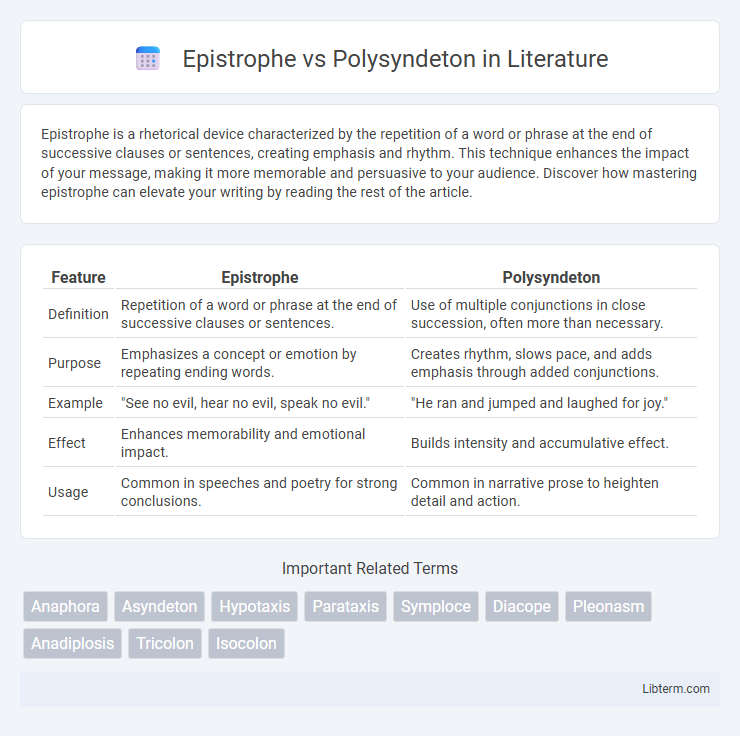Epistrophe is a rhetorical device characterized by the repetition of a word or phrase at the end of successive clauses or sentences, creating emphasis and rhythm. This technique enhances the impact of your message, making it more memorable and persuasive to your audience. Discover how mastering epistrophe can elevate your writing by reading the rest of the article.
Table of Comparison
| Feature | Epistrophe | Polysyndeton |
|---|---|---|
| Definition | Repetition of a word or phrase at the end of successive clauses or sentences. | Use of multiple conjunctions in close succession, often more than necessary. |
| Purpose | Emphasizes a concept or emotion by repeating ending words. | Creates rhythm, slows pace, and adds emphasis through added conjunctions. |
| Example | "See no evil, hear no evil, speak no evil." | "He ran and jumped and laughed for joy." |
| Effect | Enhances memorability and emotional impact. | Builds intensity and accumulative effect. |
| Usage | Common in speeches and poetry for strong conclusions. | Common in narrative prose to heighten detail and action. |
Introduction to Epistrophe and Polysyndeton
Epistrophe is a rhetorical device characterized by the repetition of a word or phrase at the end of successive sentences or clauses, enhancing emphasis and emotional impact. Polysyndeton involves the deliberate use of multiple conjunctions between each word or clause, creating a rhythmic and dramatic effect in writing or speech. Both techniques serve to strengthen arguments and engage audiences by manipulating sentence structure for persuasive or stylistic purposes.
Defining Epistrophe: Meaning and Origins
Epistrophe, originating from the Greek word "epistrophe" meaning "turning upon," is a rhetorical device involving the repetition of a word or phrase at the end of successive clauses or sentences to create emphasis and rhythm. This technique contrasts with polysyndeton, which employs multiple conjunctions between words or phrases to slow the pace and add weight. Understanding epistrophe's roots in classical rhetoric highlights its enduring impact on persuasive speech and literary expression.
Defining Polysyndeton: Meaning and Origins
Polysyndeton is a rhetorical device characterized by the deliberate use of multiple conjunctions between clauses or items in a list to create a rhythmic and emphatic effect. Originating from the Greek word "polysyndetos," meaning "bound together with many," this technique enhances the flow of sentences and underscores the importance of each element. Its strategic repetition slows the pace of prose, increasing the emotional intensity and drawing attention to the connected ideas.
Structural Differences Between Epistrophe and Polysyndeton
Epistrophe is a rhetorical device characterized by the repetition of the same word or phrase at the end of successive clauses or sentences, creating emphasis and rhythm. Polysyndeton involves the deliberate use of multiple conjunctions between words, phrases, or clauses, which slows the pace and adds a sense of accumulation. The structural difference lies in epistrophe's end-position repetition versus polysyndeton's conjunction-based linkage throughout the sentence.
Purpose and Effects in Rhetoric
Epistrophe emphasizes repetition of words or phrases at the end of successive clauses to create rhythm, reinforce a point, and evoke strong emotional responses, enhancing persuasion through memorable emphasis. Polysyndeton employs repeated conjunctions between every word or phrase, slowing pace and adding weight to each element, which cultivates a sense of abundance, urgency, or overwhelming detail in rhetoric. Both devices manipulate rhythm and structure to control audience engagement, but epistrophe drives closure and impact, while polysyndeton builds intensity and elaboration.
Famous Examples of Epistrophe in Literature
Epistrophe, characterized by the repetition of a word or phrase at the end of successive clauses, is famously exemplified in Abraham Lincoln's Gettysburg Address with the phrase "of the people, by the people, for the people." In contrast, polysyndeton employs the deliberate use of multiple conjunctions, such as in the Bible's Genesis 1: "And God said, 'Let there be light,' and there was light; and God saw the light, that it was good." These rhetorical devices enhance emphasis and rhythm in literature, with epistrophe often used to create a powerful, memorable cadence.
Notable Uses of Polysyndeton in Writing
Polysyndeton, characterized by the deliberate use of multiple conjunctions in close succession, enhances rhythm and emphasis in literary works. Notable uses of polysyndeton appear in the Bible, particularly in the Book of Genesis, where repetitive "ands" create a historical and oral storytelling effect. Ernest Hemingway and William Faulkner also employed polysyndeton to convey urgency and stream-of-consciousness narrative styles in their prose.
How to Choose Between Epistrophe and Polysyndeton
Choosing between epistrophe and polysyndeton depends on the desired rhythmic effect and emphasis in writing. Use epistrophe to highlight a repeated phrase at the end of successive clauses, creating a powerful, memorable impact. Opt for polysyndeton to slow down the rhythm and add a cumulative, deliberate tone by inserting multiple conjunctions between phrases or words.
Common Mistakes and Misunderstandings
Epistrophe and polysyndeton often get confused due to their repetitive nature, but epistrophe involves repeating the same word or phrase at the end of successive clauses, while polysyndeton uses multiple conjunctions between words, phrases, or clauses. A common mistake is treating repeated conjunctions in polysyndeton as instances of epistrophe, which undermines their distinct rhetorical effects. Misunderstanding their usage can result in weakened emphasis, as epistrophe reinforces a concluding idea, whereas polysyndeton amplifies the intensity or rhythm of a series.
Enhancing Your Writing with Epistrophe and Polysyndeton
Epistrophe enhances your writing by creating emphasis through the deliberate repetition of words or phrases at the end of successive sentences or clauses, reinforcing key ideas and making your message more memorable. Polysyndeton, characterized by the repeated use of conjunctions in close succession, slows the rhythm, adds a dramatic effect, and highlights the abundance or importance of individual elements within a list. Combining epistrophe and polysyndeton strategically enriches your prose, providing both clarity and emotional intensity that captivates readers and strengthens your narrative impact.
Epistrophe Infographic

 libterm.com
libterm.com